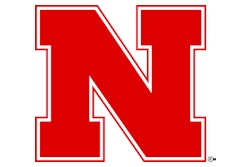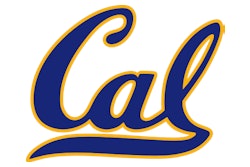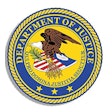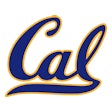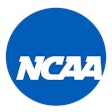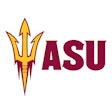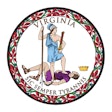The U.S. Supreme Court Crushes the Invincibility of State Activity Associations
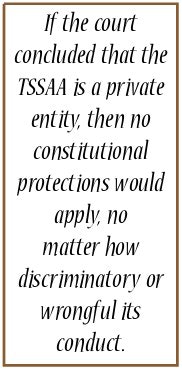
Is a private high school athletic association a private organization with its own set of rules agreed to by its members, or is it a state actor subject to constitutional review? That is the question the United States Supreme Court was asked to decide in Brentwood Academy v. Tennessee Secondary School Athletic Association [121 S. Ct. 924 (2001)]. The case arose in 1997, when the TSSAA, a not-for-profit statewide organization incorporated to regulate interscholastic athletic competition among public and private high schools in Tennessee, received allegations of recruiting violations by Brentwood Academy, a private parochial high school and a TSSAA member. In particular, the allegations claimed that Brentwood's football coach had had illegal contact with four eighth-graders [see "J'accuse," April 1998, p. 26].
As a result of the TSSAA's investigations, on July 29, 1997, Brentwood was found guilty of six recruiting rule violations. Brentwood's appeals were rejected and the association's Board of Control placed the school on probation for four years, declared its football and boys' basketball teams ineligible to compete in playoffs or engage in off-season practice for two years, and imposed a $3,000 fine. At the time, all the voting members of the Legislative Council and the Board of Control were public high school administrators. None were principals of independent or parochial schools.
That December, Brentwood sued the association and its executive director, Ronnie Carter, in federal court, claiming that enforcement of the recruiting rules qualified as state action and as such was a violation of the First and Fourteenth Amendments. The district court agreed, finding that not only had the state delegated authority over high school athletics to the TSSAA, but that the character of the association's membership and leadership was predominantly public, and that the relationship between the association and its public school members was symbiotic. The United States Sixth Circuit Court of Appeals, however, reversed the district court, finding no such symbiotic relationship and, moreover, emphasizing that the TSSAA was neither engaging in a traditional and exclusive public function nor responding to state compulsion.
To settle the issue, the U.S. Supreme Court agreed to hear the case. Before the court could address the original question of whether the TSSAA's recruiting rule violated the First or Fourteenth Amendments, however, the Supreme Court first had to answer the question of whether the association is a state actor. If the court concluded that the TSSAA is merely a private entity, then no constitutional protections would apply, no matter how discriminatory or wrongful its conduct.
All of the Supreme Court's tests used to determine state action have one common goal - to determine whether an action "can fairly be attributed to the state." In particular, the Supreme Court will find state action when it can be determined that there was such a "close nexus between the state and the challenged action" that seemingly private behavior "may be fairly treated as that of the state itself." This close nexus results from the state's exercise of "coercive power," when the state provides "significant encouragement, either overt or covert," or when a private actor operates as a "willful participant in joint activity with the state or its agents." A private entity may also be treated as a state actor when it is controlled by an "agency of the state," when it has been delegated a public function by the state, when it is "entwined with governmental policies" or when government is "entwined in [its] management or control."
In a 5-4 decision, announced on Feb. 20, 2001, the Supreme Court overturned the Sixth Circuit and ruled that the TSSAA was a state actor and not merely a private entity. Using an "entwinement" theory, the court held that the nominally private character of the association was overborne by the pervasive entwinement of public institutions and public officials in its composition and workings.
In reaching this conclusion, the court noted that since 1925, the Tennessee State Board of Education has recognized the functions of the TSSAA in providing standards, rules and regulations for interscholastic competition in Tennessee public schools. The board has even gone so far as to designate the TSSAA as "the organization to supervise and regulate the athletic activities in which the public junior and senior high schools of Tennessee participate on an interscholastic basis." In addition, in 1972, the board specifically approved the TSSAA's rules and regulations, while reserving the right to review future changes. On several occasions over the next 20 years, the board reviewed, approved or reaffirmed its approval of the recruiting rules at issue in this case.
In addition, the court pointed out that the association was not an organization of persons acting on their own, but of schools, 84 percent of which are public schools. (At the time of the suit, the TSSAA was composed of 290 public schools and 55 independent and parochial schools.) While recognizing that no school was forced to join the association, the court noted that there was no other organization that regulates interscholastic athletics and that the TSSAA enjoyed the memberships of almost all the state's public high schools.
The court also noted that the association's bylaws require that each member school be represented by its principal or a faculty member. In turn, those members select the legislative council and board of control. Both committees are composed of nine members, who under the TSSAA's bylaws must be high school principals, assistant principals or superintendents. The public school administrators who serve on the committees typically attend meetings during regular school hours. Although the TSSAA's staff members are not paid by the state, they are eligible to join the state's public retirement system for its employees. Also, while member schools pay dues to the TSSAA, the bulk of its revenue is gate receipts from athletic events, many of them held in public arenas rented by the association.
Next, the court approvingly cited two federal circuit-court cases: Clark v. Arizona Interscholastic Association [695 F.2d 1126 (1982)] and Louisiana High School Athletic Association v. St. Augustine High School [396 F.2d 224 (1968)]. In Clark, a student challenged a state high school athletic association bylaw that kept boys from playing on girls' interscholastic volleyball teams in Arizona. In the Louisiana case, a parochial school challenged the racially segregated system of interscholastic high school athletics maintained by the athletic association. In each instance, the circuit court of appeals treated the state athletic association as a state actor.
Finally, the Supreme Court addressed its decision in National Collegiate Athletic Association v. Tarkanian [488 U.S.179 (1988)], in which the court found that the NCAA was not a state actor for constitutional purposes. The Supreme Court noted in NCAA v. Tarkanian that "the situation would be different if the NCAA's membership consisted entirely of institutions located within the same state, many of them public institutions created by the same sovereign." In such a case, the court continued, state action could be found if there were public entwinement in the management or control of an organization whose member public schools were all within a single state.
In overruling the Sixth Circuit, the Supreme Court held that the TSSAA was an organization of public schools represented by their officials acting in their official capacity to provide an integral element of secondary public schooling. There would be no recognizable association, legal or tangible, without the public school officials, who do not merely control but overwhelmingly perform all but the purely ministerial acts by which the association exists and functions in practical terms. Only the 16 percent minority of private school memberships prevents this entwinement of the TSSAA and the public school system from being total, and their identities totally indistinguishable.
Although the court found the TSSAA to be a state actor, the strongly worded dissent of the court's minority is worth noting. The dissent noted that for a private organization's acts to constitute state action, the organization must perform a public function; be created, coerced or encouraged by the government; or act in a symbiotic relationship with the government. None of these elements, the dissenting judges argued, are present in the current case. In addition, the dissenters worried that because the court did not clearly define "entwinement," the court's action could expand the reach of federal law, as well as impose responsibility on a state for conduct it could not control.
With the Supreme Court's decision, the case will now head back to district court to determine if the TSSAA's recruiting rules are, in fact, a violation of the U.S. Constitution. The importance of this case, though, extends far beyond Brentwood Academy. Obviously, the court's decision could have tremendous impact on every state high school athletic association. As state actors, high school athletic associations would be subject to constitutional limitations on equal protection, due process and drug testing.
Although the TSSAA had argued that such a result would likely trigger an epidemic of unprecedented federal litigation, the court noted that every appeals court but one has found state athletics associations to be state actors, and there has been no litigation explosion in those jurisdictions. (These include Arizona, Illinois, Indiana, Louisiana, Mississippi, Missouri, Oklahoma, Pennsylvania and Rhode Island.)
The biggest impact of the decision, however, could be in college athletics. As the dissent noted, the majority's reference to NCAA v. Tarkanian is ironic because it is not difficult to imagine that application of the entwinement test could overturn the result of that case. If the NCAA were found to be a state actor, given the large number of public institutions involved in the control of the organization, then the association would be forced to modify a number of its existing rules on drug testing and eligibility.















